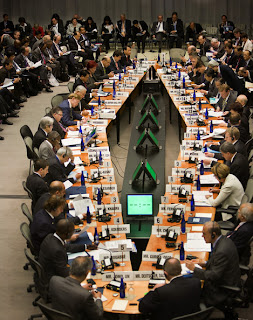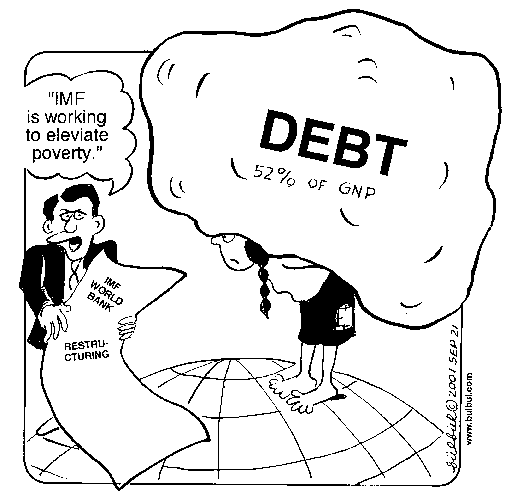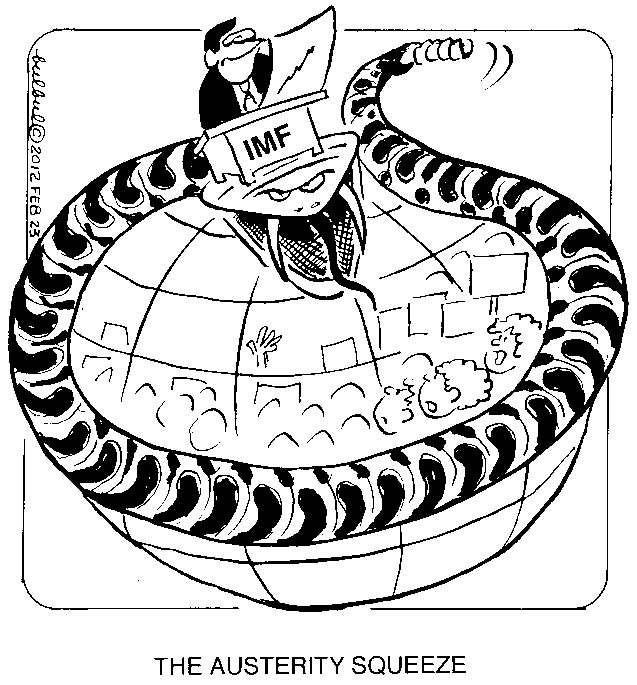Mongolia—2012 Consultation Preliminary Conclusions of the IMF Mission
Oct 25, 2012
 Mongolia continues to be one of the fastest growing economies in
the world owing to the FDI-financed development of the mining sector.
The impressive growth performance is rapidly improving living standards
and poverty declined significantly in 2011. Moreover, the economy’s
prospects are promising as copper and coal production are set to expand
considerably over the next 5 years. However, challenges are posed by (i)
the procyclicality of economic policies, leading to overheating and
increasing Mongolia’s vulnerability to macroeconomic instability; (ii)
the uncertain external outlook, which is exemplified by the recent
weakening of coal exports; and (iii) the critical importance of
implementing the fiscal framework put in place in recent years. This
statement discusses these challenges in the context of the government’s
Action Plan for 2012-2016.
Mongolia continues to be one of the fastest growing economies in
the world owing to the FDI-financed development of the mining sector.
The impressive growth performance is rapidly improving living standards
and poverty declined significantly in 2011. Moreover, the economy’s
prospects are promising as copper and coal production are set to expand
considerably over the next 5 years. However, challenges are posed by (i)
the procyclicality of economic policies, leading to overheating and
increasing Mongolia’s vulnerability to macroeconomic instability; (ii)
the uncertain external outlook, which is exemplified by the recent
weakening of coal exports; and (iii) the critical importance of
implementing the fiscal framework put in place in recent years. This
statement discusses these challenges in the context of the government’s
Action Plan for 2012-2016.I. Recent Economic Developments and Outlook
1. The Mongolian economy continues to grow very rapidly. Growth accelerated to 17 percent in 2011 and remained in low double-digits through the second quarter of 2012. Growth was buoyed by expanding coal and copper production, the ongoing development of new large mining projects, a relatively mild winter boosting agriculture, and highly expansionary fiscal policy.
2. However, inflation remains high and pressures on the balance of payments (BOP) are increasing. Unlike in other Asian countries where inflation has decelerated owing to moderating demand and lower energy and food prices, inflation in Mongolia is still around 15 percent, primarily due to rapidly rising government spending. Domestic demand pressures are driving up imports of consumption goods, and the resulting BOP pressures are compounded by weakening FDI inflows, decelerating export growth owing to weakening coal export prices, rising oil import prices and stagnating copper export volumes. In recent months, coal export volumes to China have slumped amid China’s overall decelerating imports.
3. Monetary policy has been tightened. Over the past year, in response to inflation rising substantially above the official target, the central bank increased its policy rate—by 225 basis points, to 13.25 percent—and the reserve requirements—by 700 basis points, to 12 percent. These tightening measures, which coincided with a deceleration of deposit inflows into the banking system, have been associated with a considerable slowdown in credit growth, from 72 percent in 2011 to 37 percent (year on year) in August 2012.
4. But fiscal policy has remained excessively expansionary.
- Government spending continued to soar during the first half of 2012.
In the six months leading up to the end-June elections, government
spending rose by 57 percent (year on year) as civil servants’ wages were
raised by more than 50 percent, cash handouts were stepped up, and
capital expenditures were brought forward. As revenue collection fell
short of the ambitious targets, a large domestic financing need arose
which was met mostly by drawing down bank deposits and by borrowing
about 200 billion togrogs from the BOM.

- The fiscal balance worsened by 4.7 percentage points of GDP in 2011, to a deficit of 3.5 percent of GDP. Revenue surged, thanks to VAT and customs duties collected on imports of capital goods for mining sector development. But this was more than offset by a 61 percent increase in government spending.
6. The near-term outlook for growth is favorable but inflation is projected to remain elevated:
- The mission projects inflation to remain in double digits throughout 2013.
Meat prices, which have a heavy weight in Mongolia’s CPI basket, are
projected to moderate in the coming months. However, in the context of
continued strong growth of domestic demand, the depreciation of the
exchange rate and rising oil import prices are expected to prevent a
rapid decline in inflation.

- Notwithstanding a deceleration from last year, growth is projected to remain in double digits in 2012. Rising coal production is expected to boost mineral GDP by 6.8 percent. Non-mineral GDP growth is projected at 12.8 percent, thanks to the ongoing construction and development of the OT and TT mines alongside expansionary fiscal policy.
- Growth is projected to accelerate in 2013. Mining GDP is set to increase by over half as the massive Oyu Tolgoi (OT) copper mining project starts to produce and coal production from the Tavan Tolgoi (TT) mine expands further. Non-mining GDP growth is projected at 5.4 percent in 2013, supported by government capital spending initiated in 2012 and disbursements by the Development Bank of Mongolia (DBM) for investments in roads, housing, and railways in late-2012.

8. Mongolia’s medium-term prospects are promising. The ramp up of coal production from the TT mine, the start of copper production at the OT open pit mine and the development of the OT underground mine are projected to keep the growth of mineral GDP at over 20 percent per annum, on average, during 2013-17. Activity outside the mining sector is also projected to remain buoyant, although this would need to be supported by continued reforms to strengthen the foundation of the economy and the business climate.
9. However, a number of challenges need to be addressed as the new government embarks on its Action Plan for 2012-16. Importantly, policies need to be set against the continued uncertainties in the global economic outlook. Growth in Asia has slowed, reflecting external headwinds as well as weaker momentum in China and India. The near-term outlook offers only a very gradual pickup in activity amid considerable downside risks, in particular with regard to the euro-area crisis. Potential spillovers are significant, affecting export volumes, commodity prices, and FDI inflows.
10. Against this background, it is particularly important to adopt policies that ensure macroeconomic and financial stability and that harness the country’s long-term growth potential. In particular:
- The laws that have been enacted in recent years to strengthen the fiscal policy framework—the Fiscal Stability Law (FSL), the Integrated Budget Law (IBL), and the Social Welfare Law (SWL)—now need to be implemented to ensure that Mongolia’s resource wealth not only sustains the pace of economic development, but ensures that this economic development results in a generalized improvement in living standards and reduction in poverty.
- Achievement of the government’s economic objectives will require (i) an improvement in the efficiency of public investment, to ensure that Mongolia can fund its critical economic and social investments within the existing resource constraints; and (ii) the continued implementation of structural reforms aimed at improving the business climate and private sector productivity.
- The government’s ambitious plans to establish an industrial park in
Sainshand to process mining products should avoid risks to medium-term
macroeconomic and external stability. Accordingly, the plans should
involve reputable private sector companies which mobilize their own
financing and bear a fair share of risk. The plans should be made
consistent with Mongolia’s absorptive and implementation capacity and
they should not lead to an excessive accumulation of external debt.

In the near term, the key priority is to tighten macroeconomic policies to address pressures on the external position and put inflation on a downward trajectory. Meanwhile, ongoing efforts need to continue to strengthen the framework for macroeconomic policymaking with a view to dampen volatility, mitigate risks to economic and financial stability, and strengthen natural resource management over the long term.
A. Fiscal policy
11. The mission projects the fiscal deficit in 2012 to amount to about 900 billion togrogs (6.8 percent of GDP). In the mission’s view, the Supplementary 2012 budget did not take into account the full extent of the deceleration in revenue growth so far this year, particularly for VAT and customs duties. Therefore, the mission projects that revenue will fall about 500 billion short of the target in the Supplementary 2012 budget. Even with some further compression of spending during the remainder of the year, this is expected to translate into a very large domestic financing need. The mission welcomes the authorities’ intention to raise financing through the sale of government securities to the banking system and the social security fund. Consistent with the Central Bank Law and the broad principle of sound macroeconomic policy, the government should also aim to repay the 200 billion togrog loan it took from the BOM earlier in the year.
12. The 2013 budget will be the new government’s main policy tool to safeguard macroeconomic stability and reduce Mongolia’s vulnerability to a downturn in international coal and copper prices. In light of this, the mission welcomes the government’s commitment to implement the FSL with the 2013 budget. At the same time, the mission notes the critical importance for the 2013 budget to be based on realistic macroeconomic assumptions and revenue projections. These realistic revenue projections should then be used to set spending to ensure the FSL’s 2 percent of GDP structural deficit target is achieved. The persistent revenue shortfalls in 2012 underscore the dangers of basing the budget on overly optimistic revenue projections.
13. There is considerable risk that DBM operations will undermine the achievement of the goals of the FSL. Large-scale off-budget financing of non-revenue generating public infrastructure projects would exacerbate overheating pressures and undermine the integrity and meaningfulness of the FSL as they are not covered by its limits on the structural deficit or expenditure growth. This year, the DBM plans to disburse US$600 million—equivalent to more than half of on-budget capital budget—in lending to projects in roads, railways, utilities, urban housing, and the Sainshand Industrial Park. A number of these projects, in particular roads which make up a quarter of the loans, are social benefit projects that will not generate revenues, and for which funding from the state budget will eventually be needed to repay principal and interest.
14. A clear policy needs to be drawn up to ensure that the DBM can meet the long-term infrastructure needs of Mongolia in a macro-economically sustainable manner. In the mission’s view it is imperative that the government clarify that: (i) there are limits on the aggregate lending of the DBM to ensure alignment with the principles of the FSL; (ii) that the DBM only funds revenue-generating projects; or (iii) if it is to fund social benefit projects then the amount of lending to such projects would be reflected in the state budget and so would be fully covered by the FSL. Experience in other countries shows that without a clear policy there is a risk that the DBM will be used as a non-transparent way to finance non-priority or non-viable infrastructure projects, or to bypass fiscal limits, which ultimately requires costly budget-funded bailouts. The mission also urges the government to correct weaknesses in the Law on the DBM to bring it in line with international best practice.
15. In view of the uncertain external outlook there may be a need for additional measures to safeguard macroeconomic stability over the coming year. In this regard, the mission welcomes the contingency planning that has been initiated by a working group that includes senior officials from the Ministry of Finance, the Ministry of Economic Development and the BOM. To facilitate this planning, the mission recommends that the authorities prepare a prioritized list of all capital expenditure items in the 2013 budget and defer the initiation and funding of lower-priority items until later in the fiscal year, provided revenues are on track and external pressures have eased.
16. The implementation of the Social Welfare Law (SWL) should be a priority. The SWL, which was adopted earlier this year, represents a significant step forward in efficiently fighting poverty. It introduces a means-tested benefit that would reach the poorest households and replace the existing costly universal cash transfers. Multilateral donors have provided considerable support to help set up the means-tested benefit system. The government should now move forward and roll out this system.
17. The Debt Sustainability Analysis (DSA) suggests that Mongolia’s risk of debt distress remains low, even if the DBM issues US$500 million in new government-guaranteed international bonds each year for the next five years as is presently assumed in the mission’s baseline macroeconomic projections. However, this increased rate of debt accumulation in support of the government’s Action Plan for 2012-16 would increase Mongolia’s vulnerability to shocks. To limit the risks of debt distress, recourse to non-concessional foreign financing should be limited to commercially-viable projects.
18. The establishment of a sovereign wealth fund (SWF) would be an important complement to the FSL’s countercyclical fiscal policy. The mission welcomes the efforts underway to determine the modalities of a SWF that would best fit Mongolia.
B. Monetary and Exchange Rate Policy
19. Several factors suggest that it may be appropriate for the BOM to hold off for now on further tightening measures. Inflation remains considerably in excess of the BOM’s stated target for 2012 (“inflation in single digits”). However, monetary policy has been tightened substantially over the past year, togrog liquidity remains tight, in part owing to ongoing sales of foreign exchange, and meat prices are expected to ease in the coming months. Going forward, the BOM should remain vigilant to rising inflation pressures in case fiscal policy remains too expansionary or private credit reaccelerates.
20. The BOM’s intention to move to an inflation targeting framework is appropriate. In conjunction with a floating exchange rate regime (see below), this would complement and support the countercyclical fiscal policy implied by the FSL. Next steps to strengthen the monetary policy framework involve the development of the Treasury bill market and an interbank money market.
21. The floating exchange rate regime and auction system should be maintained. Interventions should be limited to smoothing excessive exchange rate volatility without changing the underlying trend in the exchange rate. Mongolia’s foreign exchange market remains shallow and it is understandable that the authorities do not want lumpy transactions to cause jumps in the exchange rate and disorderly market conditions. However, in the mission’s view a disproportionate share of the balance of payments pressures over the past year has been absorbed through sales of official reserves. If external pressures continue this may not be sustainable. To support the external position and exchange rate regime, it is critical to maintain appropriately tight macroeconomic policies, along the lines recommended above, and to continue efforts to deepen the foreign exchange market.
22. International reserves remain adequate for precautionary purposes and the real exchange rate is broadly in line with macroeconomic fundamentals. The mission’s exchange rate assessment critically depends on FSL implementation. Mongolia’s recent experience shows that looser fiscal policy would quickly lead to considerable overvaluation.
C. Financial Sector Issues
23. Efforts to strengthen the soundness and resilience of the financial sector should continue. Financial soundness indicators have improved over the past year. The capitalization and profitability of the banking system have risen and the outstanding stock of non-performing loans has declined in absolute terms. The mission welcomes the steps taken by the BOM to (i) raise the liquidity ratio to 25 percent from 18 percent, effective January 1, 2012; and (ii) require the five systemically important banks to raise their capital adequacy ratios to 14 percent from 12 percent (to be phased in by end-2013). As a next step, in line with earlier IMF technical assistance advice provided to the BOM, the mission recommends that the BOM gradually introduce dynamic provisioning, initially requiring 1 percent provisioning for all performing loans.
24. Three years after the crisis, it is time to replace the blanket deposit guarantee scheme by a limited deposit insurance scheme. The legal and institutional underpinnings for such a limited scheme should be worked out as a matter of priority. Meanwhile, as the expiration date for the existing scheme (November 2012) draws near, the authorities should communicate transitional arrangements as soon as possible to reduce uncertainty.
25. To reduce banks’ vulnerability to exchange rate fluctuations, the authorities should consider prohibiting foreign currency lending to unhedged borrowers. The use of the togrog in domestic transaction is now firmly entrenched. However, more than one third of bank loans and bank deposits are still denominated in U.S. dollars. Currency mismatches resulting from borrowers in U.S. dollars without U.S. dollar income increase the risk of default in case of a large depreciation of the togrog vis-a-vis the U.S. dollar. Consistent with an earlier FSAP recommendation, the mission believes that this risk should be addressed by putting in place a regulation that prohibits bank lending in foreign currency to borrowers without fully hedged positions through either foreign currency income or hedging instruments. This could be phased in gradually with assets and liabilities currently on banks’ balance sheets initially grandfathered. In any case, the authorities should start to collect comprehensive data on foreign currency lending.
 26. A prohibition of foreign currency lending to unhedged
borrowers would also contribute to strengthen the monetary transmission
mechanism and develop the foreign exchange market. If enforced
consistently across all banks, a larger share of new loans would be
denominated in domestic currency. Given the existing limits on banks’
Net Open Foreign Currency Position, this would also encourage banks to
compete more for domestic currency deposits. This would have important
implications:
26. A prohibition of foreign currency lending to unhedged
borrowers would also contribute to strengthen the monetary transmission
mechanism and develop the foreign exchange market. If enforced
consistently across all banks, a larger share of new loans would be
denominated in domestic currency. Given the existing limits on banks’
Net Open Foreign Currency Position, this would also encourage banks to
compete more for domestic currency deposits. This would have important
implications:- Deepening of the foreign exchange market. Banks would lower interest rates on U.S. dollar deposits and would instead offer to buy the U.S. dollars from their depositors and sell them in the foreign exchange market.
- Strengthening of the monetary transmission mechanism. Increased competition among banks to provide loans in domestic currency and mobilize deposits in domestic currency would lead to narrower togrog interest rate spreads and would make interest rates more sensitive to changes in policy interest rates. The strengthening of the monetary transmission mechanism would eventually put the BOM in a stronger position to achieve its inflation target.
III. Structural Reforms and Other Issues
28. Efforts to improve the business climate and trade integration should be intensified. Mongolia ranks relatively high in the World Bank’s Doing Business Survey. However, there is ample scope to further streamline procedures and strengthen policy frameworks to boost private sector-led non-mineral growth. For instance, trading across borders, starting a business and dealing with construction permits remain cumbersome.

29. The new government should quickly clarify the foreign investment regime. The efficient development of Mongolia’s natural resources requires foreign financing and expertise. The perceived uncertainty regarding the foreign investment regime, particularly with regard to the mining sector, that has arisen in recent months and the political debate about the possible renegotiation of the OT contract adversely affects Mongolia’s standing among foreign investors.
30. Efforts to strengthen macroeconomics statistics should continue. Technical assistance is being provided to improve national accounts statistics. There is also scope to upgrade balance of payments statistics.



No comments:
Post a Comment